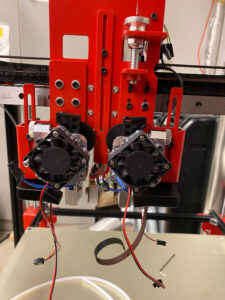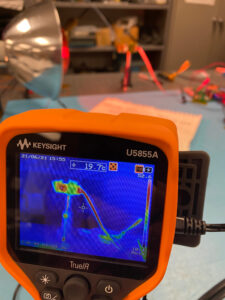Hi everyone! My name is Cutler Connaughton and I am an intern at CU Boulder through the 2021 Pinhead Internship Program. I am from the small town of Ridgway on the Westen Slope of Colorado. I traveled here to Boulder to intern at LASP or the Laboratory for Atmospheric and Space Physics. I came to Boulder specifically to measure the astronomical polarimetry of deep sky objects in space with an RIT Polarization Imaging Camera. I am working here with my mentor, Dmitry Vorobiev, who is a scientist here at LASP. I am also working with another fellow pintern Adriana, who comes from Olathe! I am staying in between the main campus of CU and their east campus, which is where I go to do my research at LASP.
This week involved Adriana and I working specifically on assembling a 3D printer, which posed to be a challenge at first, but with the help of Adriana and some quick learning, we started to make real progress on the main components of the printer itself. Adriana came to Boulder a few weeks before me and has been working with an undergrad student named Natalie. They did multiple experiments on Natalie’s MEMS project, where a tiny mirror will be able to put together photographs of faraway objects in the night sky! I helped them when needed on this project such as documenting temperatures of the camera under certain conditions.
The project that we hope to start when we finish the 3D printer, is building a rig for our special RIT camera to the biggest telescope on the campus of CU! To understand what polarization is, you first must know that most light emitted will go from its source in any direction. When measuring polarization, we look at a single light or radio wave(with them both being electromagnetic waves) and look at the direction its electric field is oscillating. In short, terms, if the electric field of the light wave we are measuring is only up and down proportional to the light wave, then it is considered polarized light. This electric field could oscillate in many directions, but to be considered polarized light, the electric field has to go in one direction or up and down a certain axis. This means you could have horizontally polarized light, where the electric field is oscillating left and right. You can have diagonally polarised light too, and in any direction really as long as the electric field is oscillating on the same axis. The reason polarized sunglasses are called so is that the lenses of the glasses only let light pass through whose electric fields are oscillating in a vertical manner, blocking out the light with electric fields that oscillate horizontally. This is why when you put on polarized glasses, you might see less light than before but might be able to see better through water because the lenses are filtering the light waves passing through.
You can imagine the RIT camera that we will be using as having each pixel on its sensor having its own mini polarizer. We will be using this camera to measure the polarity of deep sky objects in space to learn more about them.
When I first arrived in Boulder, I edited some DSLR shots of the Milkyway that I took outside of Ridgway. I use a method where I stack the exposures I take to reduce noise and grain in the photos and bring out more detail in the Milkway. Here is one of the photos that I finished that afternoon:
Thanks to all who read this blog, see you next week!




Very cool Cutler. I had no idea that is why my polarized fishing glasses worked thatway!